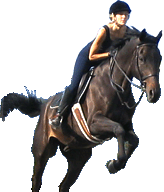|
Within the discipline of show jumping there are two distinct subdisciplines:
hunters and jumpers. On a jumping course, it is up to the rider
to cue the horse when it reaches the best take-off point. Connecting
your horse from the hind legs, through the back to the bit will
prevent most of resistance problems that horses have with jumping.
Hunt seat is a term that describes equitation in the English-style
of riding. Hunters and jumpers are first schooled thoroughly on
the flat, with ground rails/cavaletti work, then moved on to unrushed
fence work.
Hunter horse events differ from the standard jumper events. Hunters
is more about form than speed. Hunter horses are trained to calmly
jump any obstacle in their way and are judged on their appearance,
style and jumping ability. The most beautiful horse with the smoothest
round and the best jumping efforts should end up the winner.
Hunter horse events differ from the standard jumper events. The
horses used in the competition are show hunters, and are judged
on their movement, way of going, manners, and jumping form. A horse
that displays good jumping form will have its neck and back rounded
over the fence with its knees folded squarely and tight. It is also
important that the horses body stays straight while jumping, and
that the horse stays in the center of the jump. Hunter courses are
generally less demanding than jumper classes since style and manners
are critical in this form of show jumping. Precision is important
when showing in a hunter class if a horse ticks, or touches, the
fence he is jumping with his fore or hind legs, a fault is added
to the score.
Judging of show jumpers is less subjective, with the fastest clear
round winning. In Jumper classes, horse and rider aim to complete
the course within a designated time limit and without collecting
any jumping faults. In addition to the faster speed of jumper class
competition, courses in jumper classes are also composed of more
varied obstacles. As long as the horse clears the fences in a jumper
competition, the style does not matter what it looked like. In the
case of a draw, the horse with the fastest time ranks higher.
The dynamics and beauty of horse and rider soaring over fences
make jumping a thrilling sight. Natural abilities and precise training
prepare horse and rider for entry in the many different types of
jumping competitions. In all jumper classes, a fall and going 'off
course' (not following the assigned route) results in elimination.
All jumper classes use the same scoring systems. As horses and riders
move up through the jumper ranks, the fences get bigger and more
difficult. Judging of show jumpers is less subjective, with the
fastest clear round winning. In the jumper ring riders don't have
to be the most graceful rider, and horses doesn't have to be the
smoothest mover to win a jumper class.
In all hunter and jumper classes, the third refusal brings elimination.
Often hunters and jumpers show in divisions or a series of classes
where horses accumulate points in an effort to win a championship.
About the Author:
Rob Daniels has been an equestrian rider for 25 years. He has studied
various disciplines additional articles are available at: Riding
Stable - http://www.riding-stable.com
and Horse Stall http://www.horse-stall.net
About the Author
|


